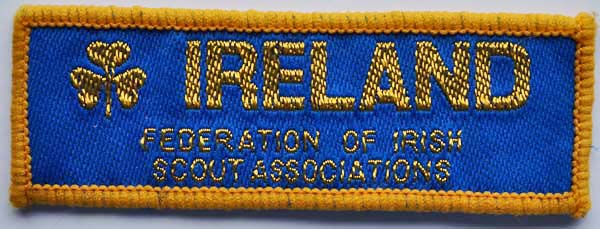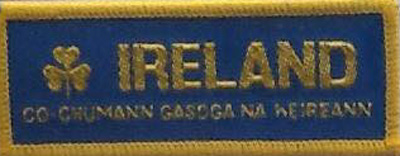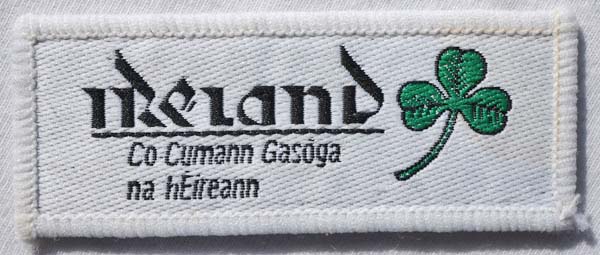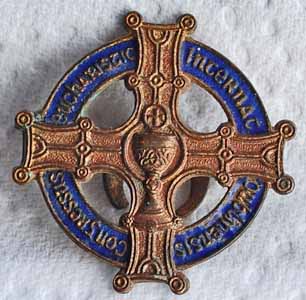Scouting History
History of Scouting in Ireland
1908 - Present The Scout Association of Northern Ireland
1908 – 1921 Part of the U.K. Scouts.
1921 – 1937 Irish Free State Scout Council.
1927 – 1983 Catholic Boys Scouts of Ireland.
1937 – 1949 Éire Scout Council.
1949 – Ireland declared itself a Republic and a new independent National Association was formed known as The Boy Scouts of Ireland. Ireland was admitted to the World Brotherhood of Scouting at the Boy Scouts’ International Conference held in Norway in September 1949.
1965 – 2004. Federation of Irish Scout associations was formed which allowed C.S.I. to be recognised by the World Organisation of the Scout Movement .
1968 – The Boy Scouts of Ireland became the Scout Association of Ireland.
1971 – C.B.S.I. Knight Errant Clans became Venture Scout Units.
1976 – Girls Admitted to Scout Association of Ireland and the first S.A.I. Beaver Colony is founded.
1978 The first C.B.S.I. Beaver Scout Colony was formed in Dublin. The new Beaver Scout section was approved by the C.B.S.I. National Council in 1980 by which time there were 26 Colonies in existence.
1983 – Catholic Scouts of Ireland girls admitted to Venture Scouts.
1999 – 2004 The Scout Association of Ireland and The Catholic Scouts of Ireland both adapt Scouting Ireland to their names becoming Scouting Ireland S.A.I. and Scouting Ireland C.S.I., in 2004 both associations dropped the S.A.I. and C.S.I. forming a united organisation Scouting Ireland.
- 2004 – Present Scouting Ireland.
   In 1965 the Federation of Irish Scout Associations was formed which allowed C.S.I. to be recognised by the World Organisation of the Scout Movement. Cumann Gasóga na hÉireann was used on the badges of the Scout Association of Ireland S.A.I., Federation of Irish Scout Associations badges had the Co before Cumann Gasóga na hÉireann when written in Irish. |
The first recorded meeting took place at the home of Mr. Richard P. Fortune, 3 Dame Street, Dublin on 15th February 1908 where four boys were enrolled in the Wolf Patrol of the 1st Dublin Troop. At the time of the first meeting Ireland was part of the U.K. When the Irish Free State was established in 1921 the Irish Free State Scout Council was formed. In 1937 de Valera (Irish President) published the 1937 constitution which changed the name from The Irish Free State to Ireland or in Gaelic Éire, the name of the Scout Council was changed to Éire Scout Council.
In 1949 the Ireland declared itself a Republic and the Éire Scout Council was changed to The Boys Scouts of Ireland.
Catholic Boy Scouts of Ireland C.B.S.I.
The C.B.S.I. was formed in 1927. In 1983 girls were admitted to Venture Scouts and the name was changed to The Catholic Scouts of Ireland. In 2004 the C.S.I. merged with the S.A.I. forming Scouting Ireland.
Oganaigh Fódla Scouts
Oganaigh Fódla (Fódlach) National Youth or Juveniles of the Nation. Before the formation of the Federation of Irish Scout Associations in 1965 C.B.S.I. Scouts could not take part in International Scouting events because they were not members of the World Organization of the Scout Movement (WOSM). I am not sure when Oganaigh Fódla was formed, the first mention of it I could find was at the World Scout Jamboree in 1947 held in France. Scouts remained members of their respective Irish Scout organisation as well as being members of Oganaigh Fódla. Oganaigh Fódla Scouts wore a white shirt instead of their usual uniform shirt.
Rawley Scouts.
Not sure if this term applied to Scouts in other Irish or world Scouting organizations but in the Catholic Boy Scouts of Ireland a Rawley Scout was a boy who had joined the Troop but had not gained his Second Class Scout badge, in order to be invested a boy had to have passed the Second Class Scout tests.
To get your Second Class Scout badge the first thing a boy had to do was know the Scout Law and Promise (see C.B.S.I. Law and Promise below). Up until the end of the 1970s and maybe beyond a boy being invested into the C.B.S.I. was expected the know the Promise and Law both of which had to be recited from memory at the investiture ceremony, having the Promise and Law read from a book and repeated by the boy was not acceptable. As if learning the Law and Promise was not enough some boys had to learn it in English and Irish.
As well as knowing the Law and Promise a boy had to demonstrate he knew and understood the principles of Scout Participation, Scout Craft and Scout Sprit.
Scout Participation was easy, attend Patrol meeting and take an active part in a hike or two and attend at least one camp.
Scout Craft. Not so easy, there were a series of 39 tests, these are listed at the back of the Scouting Trail. A boy had to demonstrate a knowledge and participate in the tests, one of which, number 36, was to be able to join in the singing of the Catholic Scout Anthem Salve Regina
Salve, Regina, Mater misericordiæ,
vita, dulcedo, et spes nostra, salve.
Ad te clamamus exsules filii Hevæ,
Ad te suspiramus, gementes et flentes
in hac lacrimarum valle.
Eia, ergo, advocata nostra, illos tuos
misericordes oculos ad nos converte;
Et Jesum, benedictum fructum ventris tui,
nobis post hoc exsilium ostende.
O clemens, O pia, O dulcis Virgo Maria.
Scout Sprit. A boy had to demonstrate he knew how to live by the Scout Law and Promise and by the principals of Scouting.
The table below lists the membership of the C.B.S.I. from 1930 to 1964 |
| Year 1930 1931 1932 1933 1934 1935 1936 1937 1938 1939 1940 1941 1942 1943 1944 1945 1946 1947 1948 1949 1950 1951 1952 1953 1954 1955 1956 1957 1958 1959 1960 1961 1962 1963 1964 | Total 3219 4452 6793 7833 8010 8471 4244 3551 3590 3366 2980 3399 3622 4148 4322 3880 3158 2929 3316 3242 3750 4180 3981 3538 4242 4502 4811 5562 5467 6891 | Chaplains/Exc 773 637 681 552 389 420 427 519 539 497 369 247 301 286 372 378 366 348 406 474 492 504 474 549 | Scouters 726 241 248 231 175 185 236 255 289 303 210 177 211 281 239 245 248 239 261 247 295 313 334 394 | Scouts 3045 2530 2527 2325 2164 2481 2587 2821 2883 2512 2134 2073 2281 2206 2486 2880 2654 2390 2795 3090 2936 3347 3245 3850 | Cubs 112 94 218 300 479 435 454 322 302 445 410 565 575 600 489 634 515* 825 1123 1123 1724 | Seniors* 65 91 92 96 72 53 29 37 68 49 28 51 25 14 19 21 6 15 98 127 218 192 208 253 | Knight Errant 85 52 42 50 86 42 43 37 108 65 95 79 53 45 69 81 107 57 48 49 45 83 83 121 |
| *Excludes Cork Seniors* also includes Sea Scouts |
Eucharistic Congress 1932An important event for the Catholic Boy Scouts of Ireland was the Eucharistic Congress held from the 22nd to the 26th of June 1922. Thousands of CBSI Scouts camped in the grounds of Terenure College in Dublin providing first aiders, marshals, escorts and lining the route of the procession.
|
The story below appeared In the January 31st 1920 edition of The Scout The Official organ of The Boy Scouts.
Scouts to the Rescue
The above image appeared on the cover with the caption Sounding the alarm which brought the 6th South Dublin (Leeson Park) Troop speeding to the rescue of a burning aeroplane. For the prompt and resourceful assistance of its members, this troop has been awarded the Silver Cross by Imperial Headquarters.
The account of the heroic rescue continues inside the magazine. Hard by the camp of the 6th South Dublin (Leeson Park) Troop at Laytown, Co. Meath, was the Gormanston Aerodrome.
Many a time the Scouts had enjoyed watching wonderful exhibitions of flight.
One day, as the Scouts were scattered about amusing themselves, they noticed that a machine was flying rather low. Suddenly there was a crash and in a moment the aeroplane was a seething mass of flames.
With great presence of mind the bugler sounded the alarm as he dashed towards the blazing machine. Scouts bobbed up from everywhere and rushed in the same direction.
Now we can let the pilot finish the tale. “Immediately on crashing my machine burst into flames. I slipped off my belt and crawled out of the seat and looked around for A.M. Gray. Not seeing him, I thought he had got clear of the machine, but on getting round the other side he was not to be seen, so I ran back to the observer’s cockpit and found him lying senseless at the bottom.
I managed to get his body out of the cockpit, but his right leg was firmly held by part of the gun mounting. Holding his body to prevent it from falling back into the pit I tried to free his right leg.
I was getting very dazed from exhaustion and the heat of the machine, when several Boy Scouts appeared, and while I held Gray’s body, they ran around to the other side and freed his right leg. Their actin was just in time, and the very least I could say Brave as the machine was a mass of flame and the heat was terrible.
The Scouts helped Gray and myself to their encampment, where they gave us First Aid treatment and brought Gray to his senses. In the meantime they had dispatched one of their number to the aerodrome and posted a guard of several others around the remains of the machine until men from the aerodrome arrived.”
For its splendid behaviour Imperial Headquarters has awarded the Silver Cross to the whole troop collectively.
Catholic Boy Scout of Ireland
I am not sure how it is now but in the 1960s and into the 1970s the C.B.S.I. had an official way in which Scouts shuld greet each other. Moladh d’Iosa Chriost (Praise be Jesus Christ) This greeting was to be met with the reply. Agus do Mhuire a Naomh Mháthair (And Mary, his blessed Mother.) The greeting was expected to be made in Gaelic but the English version was acceptable |
Catholic Boy Scout of Ireland Promise. (1960s-1970s) On my Honour, with the Grace of God, I promise to do my best to love, honour, and serve Christ my King, His Holy Church, and His Blessed Mother: to help my neighbour at all times: and to obey the Scout Law. The 2014 version of the Scouting Ireland Promise.
|
The Scout MottoCatholic Boy Scouts of Ireland, according to the 1964 edition of the Scouting Trail the meaning of the Scout Motto Bi Ullamh is explained as: Any person who sets out to be of service to others must be on the alert – soldiers, firemen, police, doctors, priests. They must be ready at any moment to go into action. They will not be able to unless:
As a Scout it will be your privilege to serve God and your neighbour. To do this you must keep your sole joined to Jesus Christ by sanctifying grace, train your body to be strong and active, fill your mind with useful knowledge, and learn to make decisions quickly. Your Scout Motto therefore is Bí Ullamh. |
The three Scout Principals of the C.B.S.I.
A Scout is true to Christ his King, honours our Blessed Lady as the Mother of God, and is proud to be a Catholic.
A Scout loves his country.
The duty of a Scout begins in his home.
C.B.S.I. Scout Law
The C.B.S.I. Scout Law had 12 points in the 1960s this was reduced over the years going down to 10 and I think there are 7 points today. The law below is from the 1964 edition of the Scouting Trail, a Scout had to learn the print in red by heart, the print in black below the red print gives the meaning of the Law, a Scout was expected to know and understand the meaning of the Law.
The 1964 edition of The Scouting Trail gives the following meaning of the Scout badge. The Scout Badge |
The Cross reminds you of your Holy Faith which is the most important thing in your life.
The Shamrock reminds you of:
The Most Holy Trinity.
The three Scout Principals, especially the second.
The three parts of the Scout Promise.
The Shamrock resting on the Cross shows that truelove of country is based on love of God, and never goes against the teachings of religion.
The C.B.S.I. Sign
Although the Scout sign is very similar around the World different Scout organizations have different meanings for the three fingers and the circle formed by the thumb and little finger. In the Catholic Boy Scouts of Ireland the circle formed by the Thumb signifies the Unity of God and the bond of friendship that joins all Scouts. The three fingers pointing straight up remind the Scout of
|
The C.B.S.I. Salute
In the Catholic Boy Scouts of Ireland the salute was given in the same circumstances as most other Scout organizations when the Scout was in uniform. When not in uniform the salute was given when:
Passing a Church or any place where the Blessed Sacrament is kept.
When the National Flag is raised or lowered.
When the National Anthem is played.
On meeting a Priest, Brother or Nun.
Passing a funeral or graveyard
When Scout Flags are carried ceremonially past the Scout.
The C.B.S.I. Prayers 1960s - 1970s
Prayer made up by Saint Ignatius, founder of the Jesuits, is the Scout prayer. You should say it every day.
Dearest Jesus, teach me to be generous,
Teach me to love and serve Thee as Thou deservest;
To give and not to count the cost;
To fight and not to heed the wounds;
To toil and not to seek for rest;
To labour and to look for no reward;
Save that of knowing that I do Thy Holy Will. Amen.
Being the C.B.S.I. one prayer was not enough and Scouts were expected to know The Scout Prayer.
We ask Thee, Almighty Father, through Jesus Christ Thy Son, to pour the gifts of Thy Sprit into the hearts of Catholic Scouts, so that they may Know, Love and serve Thee all the days of their lives. We also pray that Scouts throughout the world may come to share with us the one True Faith. Amen.
There were four Holy Days or Feast Days which all Catholic Boy Scouts were expected to attend Mass and receive Holy Communion and pray for all members of the C.B.S.I. living or dead. In the days when I used to go to Mass you had to fast from the night before and have had received absolution at Confession. The four Holy Days were:
Feast of Christ the King – Last Sunday in October.
Feast of the Immaculate Conception – 8th of December.
Feast of Saint Patrick – 17th of March.
Feast of the Holy Guardian Angels – 2nd of October.
Mass on Camp C.B.S.I.
Up to the late 1970s or early 1980s all C.B.S.I. Senior Scouts would have been expected to know how to set up the Alter on Camp. Some Scout groups would have a Priest that would regularly visit camp to say Mass and Mass would usually be said at large Scouting events such as National and Regional events. Scouts groups without a Priest to visit camp and say Mass had to endure the Scout Master’s obsession with attending 8am Mass in the Church at least an hours hike away.
If you are fortunate you will have a Priest with you on camp and have Mass each morning. Be sure you are particularly clean and tidy for Mass.
If you are not near a Church, you may find that you have to set up an altar for Mass. Place the altar stone in the centre of the table or camp-altar. Over this you lay three altar cloths, the bottom two run merely the length of the altar table, while the top cloth falls don on both sides to touch the ground.
At the back-centre of the altar, there is a Crucifix. On each side of the Crucifix is a lighted candle. These candles must be at least 65% wax. Against the base of the Crucifix you may lean the large chart (explanation below), but do not allow it to cover any part of the figures of Our Lord; if necessary raise the Crucifix on a box. The small chart goes on the Epistle side, leaning against the candlestick. The missal stand is placed straight on the Epistle side of the altar, towards the front. On it is the missal, the spine to the right.
A small table or box covered with a white cloth is put near the altar on the Epistle side. On it are the cruets, one containing wine the other water; a small bowl; a white finger towel; the Communion plate; and the bell. (The bell may also be left where the server kneels.)
If you have to lay out the scared vestments you do so in the following order: 1. Chasuble, 2. Stole, 3. Maniple, 4. Cincture - this should be doubled and the two tassels put on the right-hand side, 5. Alb, 6. Amice.The Priest himself will always dress the Chalice.
Altar Charts more commonly known as Cards (the larger is in the center, containing prayers which the priest reads at the Offertory and Canon. The smaller one on the Epistle side has the prayers read by the priest when washing his hands after the Offertory).
C.B.S.I. First Aid
One top-tip in the First Aid section of the 1964 edition of the C.B.S.I. handbook is how to perform an emergency Baptism. Every person has the power to give baptism but except in the case of necessity, only a Priest can lawfully give it. A person gives baptism by pouring water on the head of the person to be baptised saying at the same time: “I baptise thee in the name of the Father, and of the Son, and of the Holy Ghost.”
Another piece of advice given in the same book under First Aid advises the Scout, when coming across the scene of an accident to remember to say an act of contrition into the ear of the casualty as hearing is often the last sense to go in a dying person and in the fuss adults usually forget such points.
An act of contrition is a prayer said to absolve you of all your sin, in the event of a person being unable to speak another person may say the act of contrition for them, there were a few different versions but it usually went something like this:
O my God, I am heartily sorry
for having offended Thee
and I detest my sins
above every other evil
because they displease Thee, my God,
Who, in Thy infinite wisdom,
art so deserving of all my love
and I firmly resolve
with the help of Thy grace
never more to offend Thee
and to amend my life.
Amen


